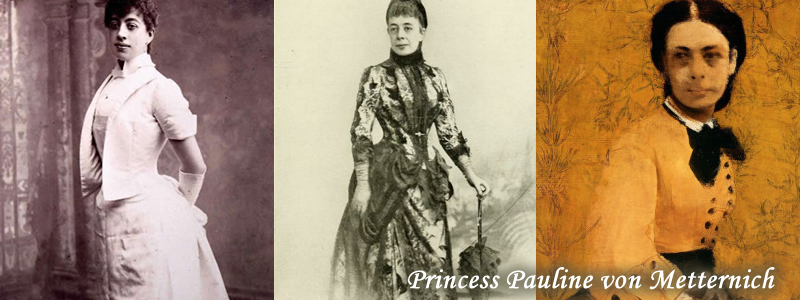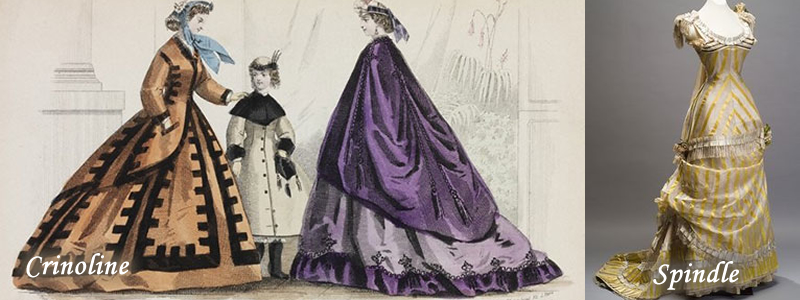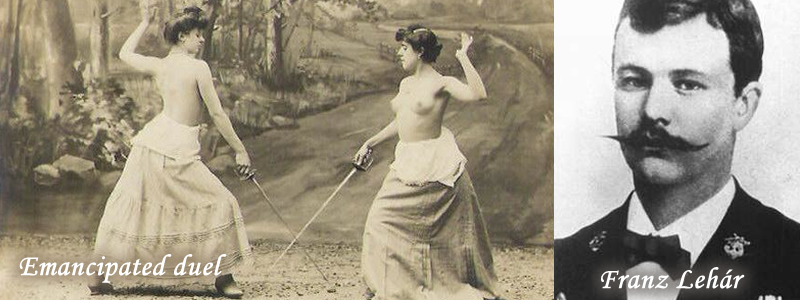 "Le singe à la mode" (the fashionable monkey) |
|
PRINCESS PAULINE VON METTERNICH. Princess Pauline Metternich-Sándor was one of the most famous women in Europe during the latter half of the nineteenth century. The tall, bulldog-faced, loud-voiced, cigar-smoking, pheasant-shooting Austrian princess, known as "La Belle Laide" (the beautiful ugly) was an unlikely fashion icon. Yet as one commentator observed of her "She is not beautiful - and was never young .. but she is chic - and that's the worst of all." The Princess made her name in European society in the 1860s in Paris during her husband's tenure as Austrian ambassador to the court of Napoleon III. She became best friends with the Empress Eugenie and on one occasion the two of them slipped out of the Royal palace together dressed as men to satisfy the Empress's curiosity to see what Paris looked like from the top of an omnibus. Pauline was dismissive of Parisian haute societe, describing its fashionable ladies as "waxworks" (she liked to perform handstands when they weren't looking) and branding the cuisine at the Emperor's summer residence as "a good restaurant of second class". |
|
 |
|
Among her other accomplishments Pauline was an amateur actress, singer and dancer whose talent and enthusiasm trumped her plainness (a contemporary aristocrat commenting on one of her ballet performances described her as "ugly as a monkey, but she made a success of it.") She also has the distinction of having introduced the Christmas tree (a tradition in her native Austria) to France. She was an enthusiastic patron of new music. In 1860 she put in a word with the Emperor Napoleon for a young German composer she was championing called Richard Wagner. The Emperor had never heard of him, but Pauline twisted his arm to get the Paris Opera to stage his opera Tannhauser. Unfortunately the headstrong Wagner broke with Parisian operatic protocol, which obliged all operas to include a ballet in the second act. This was so that the members of the aristocratic Jockey Club (who rarely turned up to the opera before the interval) could watch their favourite dancers, who were usually also their mistresses. Wagner insisted on putting his ballet at the beginning of the first act where it had more conceptual relevance. This preference for artistic integrity over convention and the convenience of the aristocracy caused an outcry. On the opening night the Jockey Club turned up early for once so that they could whistle and heckle all the way through the performance.They were willingly joined by other members of the audience who were outraged at this intrusion of Teutonic pomp into the gentility of the French opera house. The protests continued the next night and Wagner withdrew Tannhauser after three performances. Princess Pauline was one of the very few ladies to have taken part in a duel. Though "petticoat duels" between two women had been recorded before in history they were usually fought over a man. The reason for the falling out between Pauline and Countess Kilmannsegg in 1892 was a rather more mundane matter, concerning the floral arrangements for the Vienna Musical and Theatrical Exhibition on whose committee they both sat. The resulting duel took place in Vaduz, the capital of Liechtenstein, and was the first recorded "emancipated duel" in which all the participants - the combatants, the seconds and even the doctor - were women. The choice of weapons was swords and the duellists fought topless. The Princess received a slight wound on her nose and the Countess on the arm, with the Princess being adjudged the winner. |
|
 |
|
Unsurprisingly the immaculately socially connected Pauline was also a party hostess par excellence. She gave her first ball on January 7th 1860 in Paris and continued to do so for the next fifty years. She threw parties where she converted gardens into ballrooms "lighting up trees, houses and people by Bengal fires, thus giving the scene the appearance now of a veritable Eden, and anon the aspect of the realm of Lucifer" according Colonel Verly, one of her guests. On her return to Vienna in the 1870s she organised "fiacre festivals" where the whole of fashionable society cavorted around town in carriages. These occasions had exotic names like "The Japanese Cherry Blossom Festival". "The Spring Festival in a Futuristic Village" and "The Mars Festival". Having already held a "White" and a "Red" Gala Evening, she gave her legendary "Gold and Silver Ball" on Thursday 27th January 1902 at the Sophiensäle theatre in Vienna. For the occasion the theatre was flooded in gold and silver light and the ceilings hung with silvery grey muslin bedecked with golden stars. The theatre boxes were lined with silver and gold trinkets. There were trees, their trunks shimmering in the silver light of the arc lamps. Guests arrived attired in the colour of precious metals (and no doubt wearing a good deal of the real stuff). Every Vienna ball had to have a Name Waltz, so Pauline had approached the young bandmaster of the 26th regiment, one Franz Lehár, and invited him to write "a waltz to make you famous in a night". His "Gold and Silver Waltz" was actually a flop at the ball itself (because he wasn't famous the guests just talked all the way through it) but was subsequently taken up by an English publisher and soon became a staple of every light orchestra's repertoire. Three years later he composed "The Merry Widow" - possibly the most enduring and popular operetta ever written. and a particular favourite of Hitler's For Princess Pauline, though, the Gold and Silver ball was her social swan song. She lived to see the fall of the Austrian monarchy after the Great War and had to bear the indignity of being forced to sell the carriage in which she had once paraded around Vienna to a nouveau riche butcher. She died in 1921 at the age of 85. Troylus Searll. |